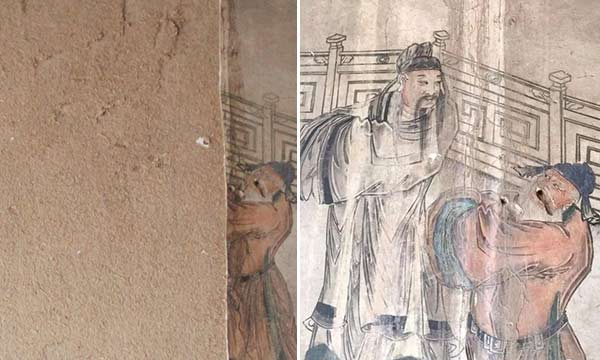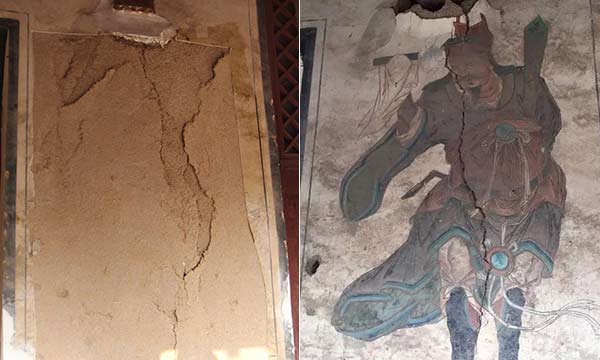Looting exposes local govt negligence, lack of incentive for protection
Cultural scholars are calling for strengthened efforts from the government and public toprotect and preserve cultural relics, after hundreds of ancient murals have been destroyedor stolen from dilapidated temples in Shanxi Province.
Police in Pingyao county spent six months tracking down more than 400 stolen murals andarrested a criminal gang of 12. Police say the missing treasures were stolen from at least 22villages in seven counties, news site thepaper.com reported earlier.
"These wall paintings were cut from the walls of ancient buildings, and the damage isalmost irreparable, which is a huge shame," said Liu Yang, a Beijing-based lawyerspecializing in cultural relics who has been working to retrieve relics overseas.
Local people said the main reason why criminals can easily steal the paintings is becausethe local government does not treat these relics seriously, and the budget for preservationof the historical relics is too low.
Tang Dahua, a local relic preservation volunteer, told thepaper.com that in some ancienttemples, there is only one volunteer from the neighborhood to keep an eye on relics, andthe government does not have a budget to hire people to do this job. Most do this for free,while only a few village heads personally provide a basic salary.
Yan Yinxi, a village officer in Xilianghe village in Pingyao, said Longtian Temple in hisvillage also lost many murals. Yan said that in his village, normally two men are in chargeof keeping the keys for a temple. They began to guard the temple day and night only afterthe paintings were hacked out and stolen
Common scene
Shanxi Province in North China is rich in cultural relics, inherited from hundreds of yearsago.
Deng Xiaohua, a local amateur historian in Pingyao, told thepaper.com that the protectionof historic relics is far from enough. "There are 400 villages in Pingyao, and on averageevery village has two ancient temples, with some big villages having 10."
"Shanxi was a prosperous place in the Qing Dynasty (1644-1911) and people liked buildingtemples and opera houses in their hometowns to prove they were successful. So in Shanxiwe can find a large number of ancient temples and historical relics above ground," Liu said.
Unlike Pingyao Ancient City, first built more than 2,700 years ago, which is listed as aUNESCO world heritage site and is under better protection, many of the ancient structuresin small villages around Pingyao are left dilapidated and suffer from erosion from the rainand wind, lamented Ni Fangliu, a Nanjing-based archeology expert.
Stealing relics like murals is very common in Pingyao and in Shanxi as a whole, because inrecent years, the economy of the province has declined, so more criminals have targetedvaluable historic and cultural treasures, lawyer Liu said.
Comprehensive solution
Experts said the temple raids are fundamentally a result of a lack of regulations andmanagement.
"Before reform and opening-up in 1978, we didn't have these problems as there was nomarket to trade cultural relics. Now the market economy has boomed, but policymakingdidn't keep pace with the situation," Ni said.
"In some cases, we can use the market economy to solve problems. For instance, make it atourist site and gather investment from society and then the government will havemotivation to do this," Ni further said.
Otherwise, the local officials will treat the preservation of historical relics as anencumbrance and they will not allocate enough resources as there are no incentives forthem, Liu added.
"The preservation of historical relics requires a comprehensive system consisting ofeducation of the public and policymakers."
 |
| (Photo/Thepaper.cn) |
Looting exposes local govt negligence, lack of incentive for protection
Cultural scholars are calling for strengthened efforts from the government and public toprotect and preserve cultural relics, after hundreds of ancient murals have been destroyedor stolen from dilapidated temples in Shanxi Province.
Police in Pingyao county spent six months tracking down more than 400 stolen murals andarrested a criminal gang of 12. Police say the missing treasures were stolen from at least 22villages in seven counties, news site thepaper.com reported earlier.
"These wall paintings were cut from the walls of ancient buildings, and the damage isalmost irreparable, which is a huge shame," said Liu Yang, a Beijing-based lawyerspecializing in cultural relics who has been working to retrieve relics overseas.
Local people said the main reason why criminals can easily steal the paintings is becausethe local government does not treat these relics seriously, and the budget for preservationof the historical relics is too low.
Tang Dahua, a local relic preservation volunteer, told thepaper.com that in some ancienttemples, there is only one volunteer from the neighborhood to keep an eye on relics, andthe government does not have a budget to hire people to do this job. Most do this for free,while only a few village heads personally provide a basic salary.
Yan Yinxi, a village officer in Xilianghe village in Pingyao, said Longtian Temple in hisvillage also lost many murals. Yan said that in his village, normally two men are in chargeof keeping the keys for a temple. They began to guard the temple day and night only afterthe paintings were hacked out and stolen
Common scene
Shanxi Province in North China is rich in cultural relics, inherited from hundreds of yearsago.
Deng Xiaohua, a local amateur historian in Pingyao, told thepaper.com that the protectionof historic relics is far from enough. "There are 400 villages in Pingyao, and on averageevery village has two ancient temples, with some big villages having 10."
"Shanxi was a prosperous place in the Qing Dynasty (1644-1911) and people liked buildingtemples and opera houses in their hometowns to prove they were successful. So in Shanxiwe can find a large number of ancient temples and historical relics above ground," Liu said.
Unlike Pingyao Ancient City, first built more than 2,700 years ago, which is listed as aUNESCO world heritage site and is under better protection, many of the ancient structuresin small villages around Pingyao are left dilapidated and suffer from erosion from the rainand wind, lamented Ni Fangliu, a Nanjing-based archeology expert.
Stealing relics like murals is very common in Pingyao and in Shanxi as a whole, because inrecent years, the economy of the province has declined, so more criminals have targetedvaluable historic and cultural treasures, lawyer Liu said.
Comprehensive solution
Experts said the temple raids are fundamentally a result of a lack of regulations andmanagement.
"Before reform and opening-up in 1978, we didn't have these problems as there was nomarket to trade cultural relics. Now the market economy has boomed, but policymakingdidn't keep pace with the situation," Ni said.
"In some cases, we can use the market economy to solve problems. For instance, make it atourist site and gather investment from society and then the government will havemotivation to do this," Ni further said.
Otherwise, the local officials will treat the preservation of historical relics as anencumbrance and they will not allocate enough resources as there are no incentives forthem, Liu added.
"The preservation of historical relics requires a comprehensive system consisting ofeducation of the public and policymakers."



